Alternative Routes to Teaching: Mapping the New Landscape of Teacher Education.
Pam Grossman and Susanna Loeb, eds. (Harvard Education Press, 2008).
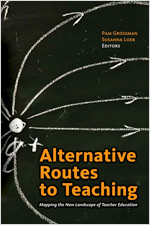 The very publication of this edited volume—from the Harvard Education Press, no less—confirms that alternative certification has gone mainstream. According to Grossman and Loeb, the number of teachers coming through nontraditional routes increased 10-fold from 1995 to 2005, to nearly 60,000. Yet, the editors explain, “Despite the pervasiveness of alternative routes, most researchers now agree that the label of ‘alternative’ says little about how teachers are actually recruited and compared.” Indeed, the great variation within this growing niche of the teacher preparation world makes it all but impossible to study. This book is a fair attempt. Particularly helpful is a chapter by Loeb and Marsha Ing that reviews the research literature on alternative certification, such as it exists. (The bottom line: a highly selective program such as Teach For America is particularly useful in recruiting top-notch talent into high schools, though elementary school teachers might benefit from more pedagogical training than these fast-entry initiatives can provide.) Loeb and Grossman conclude the book by proposing a reasonable typology that could be used to better study these programs. And, as appears mandatory for any volume like this, the editors wrap up with a call for more research and experimentation. But in this field at least, that’s a call well worth heeding.
The very publication of this edited volume—from the Harvard Education Press, no less—confirms that alternative certification has gone mainstream. According to Grossman and Loeb, the number of teachers coming through nontraditional routes increased 10-fold from 1995 to 2005, to nearly 60,000. Yet, the editors explain, “Despite the pervasiveness of alternative routes, most researchers now agree that the label of ‘alternative’ says little about how teachers are actually recruited and compared.” Indeed, the great variation within this growing niche of the teacher preparation world makes it all but impossible to study. This book is a fair attempt. Particularly helpful is a chapter by Loeb and Marsha Ing that reviews the research literature on alternative certification, such as it exists. (The bottom line: a highly selective program such as Teach For America is particularly useful in recruiting top-notch talent into high schools, though elementary school teachers might benefit from more pedagogical training than these fast-entry initiatives can provide.) Loeb and Grossman conclude the book by proposing a reasonable typology that could be used to better study these programs. And, as appears mandatory for any volume like this, the editors wrap up with a call for more research and experimentation. But in this field at least, that’s a call well worth heeding.
When Mayors Take Charge: School Governance in the City.
Joseph P. Viteritti, ed. (Brookings Institution Press, 2009).
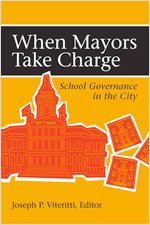 When the New York state legislature gave control of the New York City schools to the mayor in 2002, a sunset provision was included, with a deadline of June 2009. To prepare for the time when the law would be either renewed or allowed to expire, the legislature asked the public advocate for the City of New York to appoint a commission to study the issue of mayoral control and make recommendations to the legislature. Joseph Viteritti, a self-proclaimed “early and consistent proponent” of mayoral control, was named executive director of the Commission on School Governance, and in that capacity he solicited and edited the papers for this volume. The book includes general overviews of mayoral control; case studies of mayoral control in Boston, Chicago, and Detroit; and chapters looking at school governance, past and present, in New York City. Readers who are searching for a quick answer to the question of whether mayoral control improves student performance will likely be frustrated. Mayoral control can create greater capacity for change in a school system that has resisted innovation. But what happens next will of course depend on the mayor (as well as many things beyond the mayor’s control). The Commission on School Governance solicited these papers from experts in an attempt to separate the assessment of the governance arrangement from the assessment of the Bloomberg administration. But when New Yorkers debated whether to extend mayoral control in spring 2009, most people’s assessment of mayoral control reflected their assessment of Mayor Bloomberg. As for the Commission on School Governance, it released its own report to the legislature in September 2008, long before this book was published (though presumably informed by earlier drafts of these papers), urging that mayoral control be maintained but that the power of the mayor be checked and that the public be given meaningful opportunities to offer input into policy decisions.
When the New York state legislature gave control of the New York City schools to the mayor in 2002, a sunset provision was included, with a deadline of June 2009. To prepare for the time when the law would be either renewed or allowed to expire, the legislature asked the public advocate for the City of New York to appoint a commission to study the issue of mayoral control and make recommendations to the legislature. Joseph Viteritti, a self-proclaimed “early and consistent proponent” of mayoral control, was named executive director of the Commission on School Governance, and in that capacity he solicited and edited the papers for this volume. The book includes general overviews of mayoral control; case studies of mayoral control in Boston, Chicago, and Detroit; and chapters looking at school governance, past and present, in New York City. Readers who are searching for a quick answer to the question of whether mayoral control improves student performance will likely be frustrated. Mayoral control can create greater capacity for change in a school system that has resisted innovation. But what happens next will of course depend on the mayor (as well as many things beyond the mayor’s control). The Commission on School Governance solicited these papers from experts in an attempt to separate the assessment of the governance arrangement from the assessment of the Bloomberg administration. But when New Yorkers debated whether to extend mayoral control in spring 2009, most people’s assessment of mayoral control reflected their assessment of Mayor Bloomberg. As for the Commission on School Governance, it released its own report to the legislature in September 2008, long before this book was published (though presumably informed by earlier drafts of these papers), urging that mayoral control be maintained but that the power of the mayor be checked and that the public be given meaningful opportunities to offer input into policy decisions.
From A Nation at Risk to No Child Left Behind: National Education Goals and the Creation of Federal Education Policy.
Maris A. Vinovskis (Teachers College Press, 2009).
 The University of Michigan’s Maris Vinovskis is undoubtedly the most diligent, thorough, and prolific historian of education goings-on in Washington over the past quarter century, particularly when it comes to standards, assessments, and compensatory programs. He is deeply knowledgeable, incredibly industrious, and skilled at recounting complex sequences with lots of telling detail. He’s less adept at summarizing, synthesizing, and generalizing, which limits his readership. His latest volume offers readers a peerless reconstruction of the sausage factory of federal education policy between 1983 and 2008, with emphasis on the setting of national education goals by Bush I and the governors in Charlottesville in 1989, and subsequent efforts by Bill Clinton and both
The University of Michigan’s Maris Vinovskis is undoubtedly the most diligent, thorough, and prolific historian of education goings-on in Washington over the past quarter century, particularly when it comes to standards, assessments, and compensatory programs. He is deeply knowledgeable, incredibly industrious, and skilled at recounting complex sequences with lots of telling detail. He’s less adept at summarizing, synthesizing, and generalizing, which limits his readership. His latest volume offers readers a peerless reconstruction of the sausage factory of federal education policy between 1983 and 2008, with emphasis on the setting of national education goals by Bush I and the governors in Charlottesville in 1989, and subsequent efforts by Bill Clinton and both
Bushes to develop policies and programs—especially successive iterations of the Elementary and Secondary Education Act—that would bring the country closer to attaining those goals. There’s probably more here than you want or need to know. Yet you are surely grateful that Vinovskis has recounted it in such meticulous and fair-minded fashion.
Inside Urban Charter Schools: Promising Practices and Strategies in Five High-Performing Schools.
Katherine K. Merseth and coauthors (Harvard Education Press, 2009).
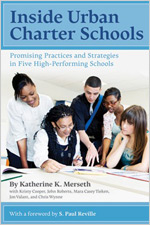 With 4,000 diverse charter schools scattered across the land, and with critics, opponents, and analysts leveling forests to publish criticisms of charter schooling, it’s refreshing and heartening to find a thoughtful analysis of successful charters. The Harvard ed school’s Kay Merseth, with a platoon of research helpers and fueled by a federal research grant, examined five high-performing (urban) charters in the Boston metro area to see what makes them tick, and what they have in common. The resulting book is first-rate: five insightful case studies of individual schools followed by analytic chapters on “cross-school themes.” Perhaps unsurprisingly, these themes include school culture, leadership, personnel, “structures and systems,” and curriculum and instruction. It’s no cookbook or instruction manual; it doesn’t tell you how to create a successful charter from scratch, much less how to turn around those that are lacking. But it lucidly describes, depicts, and explains the crucial elements that these five schools have put into place that very likely account for their success.
With 4,000 diverse charter schools scattered across the land, and with critics, opponents, and analysts leveling forests to publish criticisms of charter schooling, it’s refreshing and heartening to find a thoughtful analysis of successful charters. The Harvard ed school’s Kay Merseth, with a platoon of research helpers and fueled by a federal research grant, examined five high-performing (urban) charters in the Boston metro area to see what makes them tick, and what they have in common. The resulting book is first-rate: five insightful case studies of individual schools followed by analytic chapters on “cross-school themes.” Perhaps unsurprisingly, these themes include school culture, leadership, personnel, “structures and systems,” and curriculum and instruction. It’s no cookbook or instruction manual; it doesn’t tell you how to create a successful charter from scratch, much less how to turn around those that are lacking. But it lucidly describes, depicts, and explains the crucial elements that these five schools have put into place that very likely account for their success.
The Role and Impact of Public-Private Partnerships in Education.
Harry Anthony Patrinos, Felipe Barrera-Osorio, and Juliana Guaqueta (World Bank Publications, 2009).
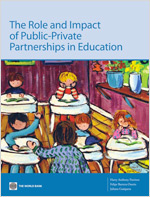 This slender volume provides an invaluable overview of the role that private ventures can play in K—12 schooling. The topic is especially timely given that, as the authors note, the percentage of students in private schools worldwide has doubled from 5 to 10 percent since 1991, according to UNESCO. Patrinos and his coauthors explain the array of possible arrangements and survey the international experience and research findings to provide clear guidance to policymakers. The best-known form of public-private partnership in schooling is a voucher plan that includes private schools. But the authors flag the many different roles that private providers play around the world when it comes to professional services (think teacher training or textbook delivery), support services (think meals and transportation), school management, and facilities. Examples illustrate how public agencies in various nations, from New Zealand to Pakistan, arrange for private operators to handle services. Patrinos and his colleagues argue that partnerships can deliver competition, flexibility, and risk sharing, and that sensible attention to arrangements can minimize potential downsides. In particular, they emphasize the importance of transparent and competitive processes for selecting private partners, the need for public agencies to separate the roles of purchasing and service provision, and the importance of sensible performance metrics and outcome goals. All in all, a useful primer for reformers and policymakers.
This slender volume provides an invaluable overview of the role that private ventures can play in K—12 schooling. The topic is especially timely given that, as the authors note, the percentage of students in private schools worldwide has doubled from 5 to 10 percent since 1991, according to UNESCO. Patrinos and his coauthors explain the array of possible arrangements and survey the international experience and research findings to provide clear guidance to policymakers. The best-known form of public-private partnership in schooling is a voucher plan that includes private schools. But the authors flag the many different roles that private providers play around the world when it comes to professional services (think teacher training or textbook delivery), support services (think meals and transportation), school management, and facilities. Examples illustrate how public agencies in various nations, from New Zealand to Pakistan, arrange for private operators to handle services. Patrinos and his colleagues argue that partnerships can deliver competition, flexibility, and risk sharing, and that sensible attention to arrangements can minimize potential downsides. In particular, they emphasize the importance of transparent and competitive processes for selecting private partners, the need for public agencies to separate the roles of purchasing and service provision, and the importance of sensible performance metrics and outcome goals. All in all, a useful primer for reformers and policymakers.
The Latino Education Crisis: The Consequences of Failed Social Policies.
Patricia Gándara and Frances Contreras (Harvard University Press, 2009).
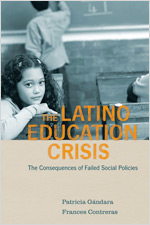 Are our schools serving Latinos, the largest immigrant group of our time, as well as—or better than—our schools served immigrants in the past? Or are they suffering systematic discrimination and deprivation that will doom them to marginal status for generations? Is it better to be quickly immersed in the language of the host country or to be taught in one’s native tongue? Little is known about such matters. Gándara and Contreras do a better job of delineating the knowledge gap than filling it. For example, not much attention is given to the desperate state of the Mexican education system that has helped prompt the emigration across our borders. If the authors are quite objective in their summary of existing research, they, as their title suggests, do a better job at assigning blame than identifying anything other than standard remedies.
Are our schools serving Latinos, the largest immigrant group of our time, as well as—or better than—our schools served immigrants in the past? Or are they suffering systematic discrimination and deprivation that will doom them to marginal status for generations? Is it better to be quickly immersed in the language of the host country or to be taught in one’s native tongue? Little is known about such matters. Gándara and Contreras do a better job of delineating the knowledge gap than filling it. For example, not much attention is given to the desperate state of the Mexican education system that has helped prompt the emigration across our borders. If the authors are quite objective in their summary of existing research, they, as their title suggests, do a better job at assigning blame than identifying anything other than standard remedies.


